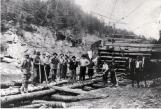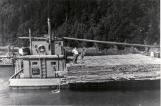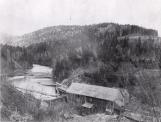14
A group of workmen standing on the wharf at Point Wolfe.
19 September 1915
Point Wolfe, New Brunswick, Canada

15
If that was not possible smaller ships called scows would transport the lumber from the mill to ships waiting to be loaded out in the Bay.
16
'The Manning' hauling a load of lumber from the wharf at Point Wolfe to a ship out in the Bay.
19 September 1915
Point Wolfe, New Brunswick, Canada

17
During the 1840's and 1850's, demand for lumber increased and larger operations which could meet this demand began to be established. In Albert County, the major ‘driving rivers' were the Point Wolfe, Alma, Crooked Creek, and Pollett Rivers.
18
The I.C. Prescott mill at Crooked Creek.
19 September 1915
Albert, New Brunswick, Canada

19
The mills built on these rivers generally sawed from 5 to 6 million board feet per year, compared to the smaller mills in the area which generally sawed a few hundred thousand board feet per year. The largest of these mills was the C.T. White sawmill at Point Wolfe, it operated twenty-four hours a day. By the 1880's most of the bigger mills had converted from water power to steam power. The last ‘river drive' in Albert County was in 1951 on the Alma River. By that time many of the lumbering operations in the area had changed back to smaller ‘portable sawmills' that sawed the lumber close to where it was harvested instead of ‘river driving' the logs over great distances by water to the mills. The sawmills of this era were powered by both steam and diesel/gas engines. The sawed lumber was then hauled by teams of horses or by trucks to the railways or seaports for shipment to market. The end of the era of wooden ships during the early twentieth century greatly reduced the demand for timber. At the same time, the large lumber companies, rather than modernizing timber operations to harvest smaller trees or to harvest timber farther away from the mills, instead shifted operations to the untouched timber lands of Northwestern North America. Although lumbering is still an important part of the economy of Albert County, the days of the great river drives are over.


